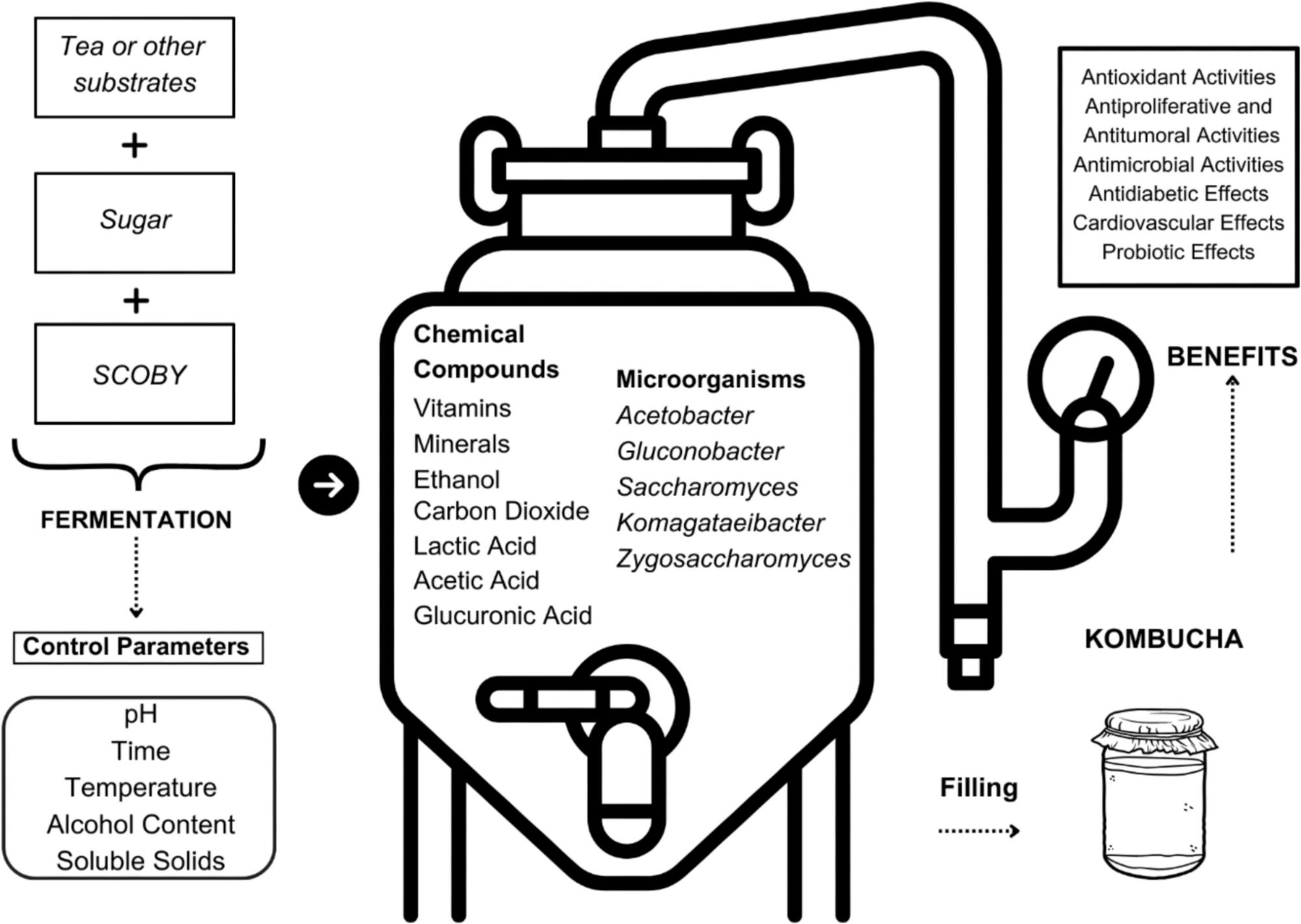Introduction
Microbial composition and fermentation process
Nutritional profile and bioactive components
Health benefits and mechanisms of action
Evidence from preclinical and clinical studies
Safety, quality control, and regulation
Future directions
Conclusions
References
Further reading
Discover how kombucha’s unique fermentation transforms ordinary tea into a complex brew of polyphenols and bioactive compounds, promising benefits for gut health, metabolic balance, and beyond, but what does the science really say?
 Image Credit: D-Krab / Shutterstock.com
Image Credit: D-Krab / Shutterstock.com
Introduction
Kombucha is a sweetened tea fermented by a symbiotic culture of bacteria and yeast (SCOBY). As the wellness and functional nutrition markets expand, particularly in the United States, the consumption of kombucha has also risen due to its perceived probiotic and intestinal health benefits.1
Microbial composition and fermentation process
The SCOBY for kombucha typically comprises osmophilic yeasts like Brettanomyces, Candida, Lachancea, Pichia, Saccharomyces, Schizosaccharomyces, and Zygosaccharomyces. Acetic acid bacteria, such as Acetobacter, Gluconobacter, and Komagataeibacter, as well as occasionally Lactobacillus species, will also be present.1,2
Within the SCOBY, yeasts secrete invertase that cleaves sucrose into glucose and fructose, which leads to the release of carbon dioxide and ethanol. Acetic-acid bacteria oxidize these substrates to produce acetic, gluconic, and glucuronic acids, which simultaneously reduce pH and form the cellulose pellicle that becomes the daughter SCOBY.1,2
 Production stages and control parameters for Kombucha1 - Onsun, B., Toprak, K. & Sanlier, N. (2025)
Production stages and control parameters for Kombucha1 - Onsun, B., Toprak, K. & Sanlier, N. (2025)
Fermentation yields a final product that comprises these organic acids, trace amounts of alcohol, water-soluble B vitamins (B1, B2, and B6, occasionally B12, although its presence is inconsistent and not reliably bioavailable), as well as other antimicrobial compounds for stabilization.1,2
Black, green, oolong, or white tea can be used to prepare kombucha, each with a distinct polyphenol and mineral profile. The duration of fermentation, which ranges between five and 14 days, also determines the concentrations of acid, ethanol, and vitamins, which subsequently dictate whether the drink will taste tart or have stronger vinegar undertones. Understanding these variables enables brewers to adjust the flavor, carbonation, and functional properties of their kombucha products.1,2
Nutritional profile and bioactive components
Green tea provides abundant catechins, including epigallocatechin gallate, a potent radical scavenger. Black tea contributes oxidized polyphenols like theaflavins and thearubigins, which affect the color and antioxidant capacity of kombucha.
During fermentation, microbial enzymes can hydrolyze larger polyphenols, releasing smaller and more bioavailable molecules in the process. These enzymes can also increase total phenolic levels and antioxidant activity as compared to unfermented tea products.3
The living SCOBY consists of acetic acid bacteria, lactic acid bacteria, and yeasts that regulate nutrient release and may act as a probiotic source, though human evidence is lacking. The potential probiotic properties of kombucha underscore the importance of proper product handling, as certain storage conditions or pasteurization can reduce the live counts. Nevertheless, inactivated cells and their metabolites may act as postbiotics and, as a result, provide additional health effects.3
Kombucha is rich in various organic acids that exhibit distinct detoxification properties. Glucuronic acid, produced by Komagataeibacter species, for example, has been shown in preclinical studies to bind hepatic toxins, support glucuronidation, enhance the bioavailability of phenolic compounds, and modulate steroid hormone balance. However, such detoxification effects in humans remain unproven.
What is Kombucha?
Health benefits and mechanisms of action
Many of the health benefits frequently associated with kombucha can be attributed to its symbiotic culture of bacteria and yeast, as well as organic acids and tea polyphenols, which reach the colon and may act as prebiotics. However, this classification requires further validation in human studies. These compounds can stimulate beneficial taxa, increase short-chain fatty acid (SCFA) production, and improve stool consistency. More specifically, organic acids have been shown in animal studies to enhance motility through prostaglandin E2 (PGE2) signaling and reduced aquaporin-3 expression, thereby supporting barrier and mucosal immune function.2,4
Tea polyphenols and fermentation metabolites provide antioxidant and anti-inflammatory actions. Some of the different pathways implicated in these properties include the activation of nuclear factor erythroid 2-related factor 2 (NRF2), increased superoxide dismutase and catalase activity, as well as reduced levels of glutathione and interleukin-6 (IL-6). High levels of glucuronic acid and D-saccharic acid 1,4-lactone support hepatic and renal detoxification by increasing glucuronidation and inhibiting beta-glucuronidase, while simultaneously limiting lipid peroxidation.
Preclinical research suggests that kombucha can also improve insulin secretion, as well as reduce glucose absorption, gut-derived incretin signaling, and adipogenesis. However, human trials report mixed effects on fasting glucose, insulin resistance, lipids, gamma-glutamyl transferase, and lipid accumulation product. Thus, larger and longer controlled studies must be conducted to validate these mechanisms in diverse populations and assess clinically relevant outcomes globally.2,4
 Potential molecular mechanisms involved in the promising health benefits of kombucha consumption. The rich composition of kombucha, including organic acids and phenolic compounds, provides potent antioxidant and anti-inflammatory properties that influence multiple molecular pathways across organs. Phenolic compounds exert prebiotic effects by modulating the salivary and fecal microbiota, lowering fecal pH, stimulating the growth of beneficial bacteria, and increasing the production of short-chain fatty acids (SCFAs). This enhances gut barrier function and regulates metabolic, immune, and inflammatory responses. Additionally, kombucha’s bioactive compounds exhibit antimicrobial properties, reducing the presence of oral pathogens associated with periodontitis and cavities. In the gut, organic acids enhance motility by stimulating the secretion of prostaglandin E2, promoting peristalsis, and downregulating aquaporin-3, resulting in softer stools and increased volume. Kombucha also activates SIRT-1 and AMPK, suppressing chronic inflammation via NF-κB inhibition, boosting mitochondrial biogenesis and ATP catabolism, while reducing lipogenesis and hepatic cholesterol synthesis—mechanisms associated with improved energy expenditure and anti-obesity effects. Furthermore, it mitigates hepatic fat accumulation by downregulating lipid-related genes (CD36, PPAR-γ, SREBP-1C) and enhancing β-oxidation. Regarding glucose metabolism, kombucha supports pancreatic function, improves insulin secretion, and reduces glucose absorption by inhibiting α-amylase and GLUT1, mediated by its low pH and microbial activity. Its high organic acid content also promotes hepatic and renal detoxification via glucuronidation, enhancing toxin elimination and protecting against oxidative stress. Additionally, kombucha activates NRF2 signaling, boosting antioxidant defenses through increased expression of enzymes like SOD, CAT, and GSH. ↑: increased; ↓: decreased. 4 - Antolak H, Piechota D, Kucharska A. (2021)
Potential molecular mechanisms involved in the promising health benefits of kombucha consumption. The rich composition of kombucha, including organic acids and phenolic compounds, provides potent antioxidant and anti-inflammatory properties that influence multiple molecular pathways across organs. Phenolic compounds exert prebiotic effects by modulating the salivary and fecal microbiota, lowering fecal pH, stimulating the growth of beneficial bacteria, and increasing the production of short-chain fatty acids (SCFAs). This enhances gut barrier function and regulates metabolic, immune, and inflammatory responses. Additionally, kombucha’s bioactive compounds exhibit antimicrobial properties, reducing the presence of oral pathogens associated with periodontitis and cavities. In the gut, organic acids enhance motility by stimulating the secretion of prostaglandin E2, promoting peristalsis, and downregulating aquaporin-3, resulting in softer stools and increased volume. Kombucha also activates SIRT-1 and AMPK, suppressing chronic inflammation via NF-κB inhibition, boosting mitochondrial biogenesis and ATP catabolism, while reducing lipogenesis and hepatic cholesterol synthesis—mechanisms associated with improved energy expenditure and anti-obesity effects. Furthermore, it mitigates hepatic fat accumulation by downregulating lipid-related genes (CD36, PPAR-γ, SREBP-1C) and enhancing β-oxidation. Regarding glucose metabolism, kombucha supports pancreatic function, improves insulin secretion, and reduces glucose absorption by inhibiting α-amylase and GLUT1, mediated by its low pH and microbial activity. Its high organic acid content also promotes hepatic and renal detoxification via glucuronidation, enhancing toxin elimination and protecting against oxidative stress. Additionally, kombucha activates NRF2 signaling, boosting antioxidant defenses through increased expression of enzymes like SOD, CAT, and GSH. ↑: increased; ↓: decreased. 4 - Antolak H, Piechota D, Kucharska A. (2021)
Evidence from preclinical and clinical studies
The tea polyphenols and fermentation metabolites present in kombucha exhibit distinct antimicrobial, antioxidant, detoxifying, immune-stimulating, and disease-modifying properties, as reported in rodent, rabbit, poultry, livestock, and cell models. For example, diabetic animal studies have reported lower glucose levels, beta-cell regeneration, improved metabolism and liver outcomes, as well as improved survival outcomes in rodent models of sepsis.5,6
Translation of these observations into human trials is limited by variable SCOBY composition, complex metabolites, unverified historical claims, as well as small, self-reported, and single-product trials. Thus, standardized brewing protocols and larger studies are needed to define clinically meaningful outcomes in diverse populations and endpoints over time.5,6
Safety, quality control, and regulation
Contamination of kombucha products can occur from sharing a SCOBY, poor sanitation practices, or failure to acidify the product appropriately. Batches with visible mold contamination or those with a pH exceeding 4.2 should be discarded.
Hazard Analysis and Critical Control Point (HACCP) guidance advises kombucha consumers to use clean equipment and food-grade vessels, monitor their fermentation process for seven to ten days, target a final pH of at least 2.5, and moderate intake to avoid excess organic acids, ethanol, and acidosis. Importantly, heavy consumption of home‑brewed kombucha increases the risk of hepatitis‑like illness, gastrointestinal symptoms, renal failure, myositis, pellagra, and rare metabolic acidosis.7
Alcohol by volume (ABV) levels in kombucha products meet regional non‑alcoholic limits, which are typically below 0.5%. Nevertheless, some products may exceed these acceptable ABV levels, which can result in recalls and tax debates. Accurate labeling and evidence for probiotic or health claims remain regulatory priorities, particularly in expanding markets and amid growing global consumer confidence.7
 Image Credit: Top stock photos / Shutterstock.com
Image Credit: Top stock photos / Shutterstock.com
Future directions
Consistent starter cultures, substrates, fermentation times, temperature, pH, and packaging control are essential to generate reproducible chemistry, ensure safety, and allow data from different labs to be compared. Regulatory bodies, industry, and researchers are encouraged to collaborate on quality standards that protect consumers and reduce variability across products.8
Additional studies are needed to optimize fermentation strategies, strain selection, and process optimization to enrich for polyphenols, vitamins, organic acids, and other targeted compounds while retaining product acceptability. Standardized outcome sets and reporting templates will enhance comparability and facilitate future meta-analyses across studies.8
Conclusions
Kombucha is a fermented tea rich in polyphenols, organic acids, and microbial components that may contribute to prebiotic-like effects, supporting gut function, metabolic regulation, and detoxification. Despite its reported health benefits, there remains a lack of evidence supporting these claims from human trials, with existing data largely heterogeneous and of low quality. Consumers should choose properly acidified, well-handled products and drink in moderation, especially if immunocompromised, pregnant, or managing chronic disease.
References
- Onsun, B., Toprak, K. & Sanlier, N. (2025). Kombucha Tea: A Functional Beverage and All its Aspects. Curr Nutr Rep 14(1). DOI:10.1007/s13668-025-00658-9, https://link.springer.com/article/10.1007/s13668-025-00658-9
- Suriyapriya Selvaraj, Kalaichelvan Gurumurthy. (2023). An overview of probiotic health booster-kombucha tea, Chinese Herbal Medicines, 15 (1) 27-32. DOI:10.1016/j.chmed.2022.06.010, https://www.sciencedirect.com/science/article/pii/S1674638422001289
- Antolak H, Piechota D, Kucharska A. (2021) Kombucha Tea—A Double Power of Bioactive Compounds from Tea and Symbiotic Culture of Bacteria and Yeasts (SCOBY). Antioxidants. 10(10). DOI:10.3390/antiox10101541, https://www.mdpi.com/2076-3921/10/10/1541
- Fraiz GM, Bonifácio DB, de Paulo RS, Teixeira CM, Martino HSD, Barros FARd, Milagro FI, Bressan J. (2025). Benefits of Kombucha Consumption: A Systematic Review of Clinical Trials Focused on Microbiota and Metabolic Health. Fermentation. 11(6). DOI:10.3390/fermentation11060353, https://www.mdpi.com/2311-5637/11/6/353
- Julie M. Kapp, Walton Sumner. (2019). Kombucha: a systematic review of the empirical evidence of human health benefit. Annals of Epidemiology, 30. 66-70. DOI:10.1016/j.annepidem.2018.11.001, https://www.sciencedirect.com/science/article/pii/S1047279718307385
- Mendelson C, Sparkes S, Merenstein DJ, Christensen C, Sharma V, Desale S, Auchtung JM, Kok CR, Hallen-Adams HE and Hutkins R. (2023). Kombucha tea as an anti-hyperglycemic agent in humans with diabetes– a randomized controlled pilot investigation. Front. Nutr. 10. DOI:10.3389/fnut.2023.1190248, https://www.frontiersin.org/journals/nutrition/articles/10.3389/fnut.2023.1190248/full
- Nyhan LM, Lynch KM, Sahin AW, Arendt EK. (2022) Advances in Kombucha Tea Fermentation: A Review. Applied Microbiology. 2(1) 73-103. DOI:10.3390/applmicrobiol2010005, https://www.mdpi.com/2673-8007/2/1/5
- Batista P, Penas MR, Pintado M, Oliveira-Silva P. (2022). Kombucha: Perceptions and Future Prospects. Foods. 11(13). DOI:10.3390/foods11131977, https://www.mdpi.com/2304-8158/11/13/1977
Further Reading
Last Updated: Jul 27, 2025